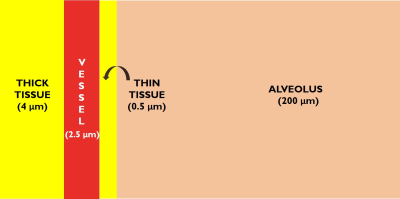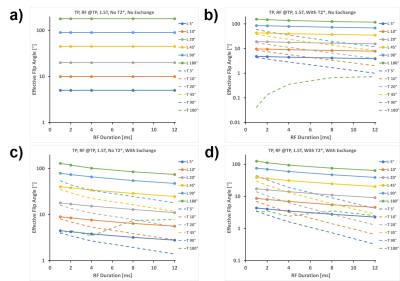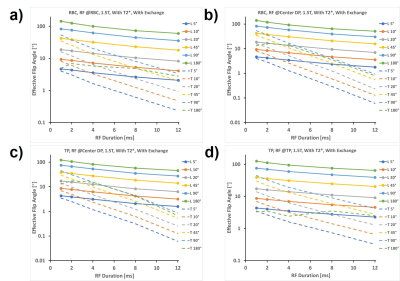2369
The Impact of T2* And Pulmonary Gas Exchange on The Accuracy Of The Applied Dissolved-phase Flip Angle in Hyperpolarized Xenon-129 MRI?
Yiwen Qian1, Kai Ruppert1, Faraz Amzajerdian1, Yi Xin1, Hooman Hamedani1, Luis Loza1, Tahmina S. Achekzai1, Ryan J. Baron1, Ian F. Duncan1, Harrilla Profka1, Mehrdad Pourfathi1, Federico Sertic1, Stephen Kadlecek1, and Rahim R. Rizi1
1Radiology, University of Pennsylvania, Philadelhia, PA, United States
1Radiology, University of Pennsylvania, Philadelhia, PA, United States
Synopsis
The fleeting nature of hyperpolarized xenon-129 magnetization necessitates a separate flip angle calibration procedure based on the decay of the gas-phase signal. This calibration is subsequently assumed to be valid for imaging of the xenon dissolved in the lung tissue despite the rapid exchange between the parenchyma and the alveolar gas volume and despite that the T2* is much shorter in the former than in the latter. In this work we implemented a 1-dimensional gas exchange simulation and investigated to what extent the effective flip angle at the dissolved-phase frequencies is affected by exchange and acquisition parameters.
Purpose
Unlike in proton MRI, the fleeting nature of hyperpolarized xenon-129 (HXe) magnetization necessitates a separate flip angle calibration procedure during which a series of RF pulses is applied at the gas-phase frequency and the flip angle is extracted from the decay of the gas-phase signal. This calibration is subsequently assumed to be valid for imaging of the xenon dissolved in the lung tissue despite the rapid exchange between the parenchyma and the alveolar gas volume and despite that the T2* is much shorter in the former than in the latter. In this work we implemented a 1-dimensional gas exchange simulation and investigated to what extent the effective flip angle at the dissolved-phase (DP) frequencies is affected by exchange and acquisition parameters.Methods
A 1-dimensional numerical lung model was used for the simulation of xenon gas exchange between the tissue-plasma (TP) and red blood cell (RBC) compartments comprising a single alveolus (Fig. 1). At the start of the simulation one million xenon were randomly distributed across the compartments in Fig. 1 such that 98% were in the alveolar gas phase (GP) and the remainder in the DP. Random diffusional motion was simulated at 1 ms time increments with diffusion constants of 0.68 10-5 m2s-1 in the GP and 0.33 10-9 m2s-1 in the DP, respectively. To maintain the prescribed concentration ratio the probability for entering the DP was set to 5.7%. For each time increment the effect of a Gaussian RF pulse (duration 1-12 ms, flip angle 5°-180°) and B0-inhomogeneity induced T2* on the magnetization vectors of the atoms were calculated. Four conditions were simulated: no gas exchange, no T2* effects, both effects, or neither effect. gas exchange and T2* and without gas exchange or T2*. Also, the center frequency of the RF pulse was varied between 198 ppm (TP), 218 ppm (RBC) and 208 ppm (in between DP resonances). To isolate the impact of exchange and T2*, the RF pulse was assumed to leave the GP magnetization unaffected and no blood flow was simulated. The effective longitudinal and transverse flip angles as a function of the simulated nominal flip angles was calculated for all conditions.Results and Discussion
Figure 2 shows the impact of gas exchange and T2* on the effectiveness of a Gaussian RF pulse centered at the TP frequency. Without T2* and gas exchange the effective flip angles were identical to the nominal ones (Fig. 2a). flip angles applied in the simulations when the Rf pulse was at the tissue frequency (Fig 2a). When T2* is taken into consideration the effective longitudinal flip angle is still fairly close to its nominal value but the transverse flip angle diverges as a function of RF duration. Gas exchange (Fig. 2c) strongly affects longitudinal and transverse magnetization and both effects combined compound the observed deviations. Figure 3 demonstrates that T2* and gas exchange affect the effective flip angle at RBC and TP resonance differently with larger deviations found for the TP resonance due to a more direct impact of gas exchange between TP and GP.Conclusion
We demonstrated that gas exchange and T2* strongly impact the effective flip angle for the DP magnetization. This effect is of particular importance but largely underappreciated for precise measurements of pulmonary gas exchange.Acknowledgements
Supported by NIH grants R01 EB015767, R01 HL129805, S10 OD018203 and R01 CA193050.References
No reference found.Figures

Figure 1. Schematic of the
simulated 1-dimensional pulmonary gas exchange model. A gas-filled alveolus (0
ppm) is separated by a thin and a thick tissue barrier (198 ppm) from a blood
vessel containing red blood cells (218 ppm). Xenon atoms are simulated as
diffusing freely within the alveolus and reenter the depicted lung volume from
the left when leaving at the right.

Figure 2. Effective TP transverse
and longitudinal flip angles as a function of RF pulse duration for nominal flip
angles ranging from 5° to 180°. a) TP flip angles for RF pulses centered at TP
resonance without T2* and without gas exchange; b) Same as a) but with
simulated B0-inhomogeneity induced T2*; c) Same as a) but with gas exchange
between gas-phase and dissolved-phase compartments; d) Same as a) but with
simulated B0-inhomogeneity induced T2* as well as gas exchange between gas-phase
and dissolved-phase compartments.

Figure 3. Effective DP transverse
and longitudinal flip angles as a function of RF pulse duration for nominal flip
angles ranging from 5° to 180°. a) RBC flip angles for RF pulses centered at RBC
resonance with simulated B0-inhomogeneity induced T2* as well as gas exchange
between gas-phase and dissolved-phase compartments; b) Same as a) but with RF
pulse centered in between RBC and DP resonances; c) Same as b) but for TP flip
angles; d) Same as a) but for TP flip angles for RF pulses centered at TP
resonance.